new posts in all blogs
Viewing: Blog Posts Tagged with: simon and schuster, Most Recent at Top [Help]
Results 26 - 50 of 229
How to use this Page
You are viewing the most recent posts tagged with the words: simon and schuster in the JacketFlap blog reader. What is a tag? Think of a tag as a keyword or category label. Tags can both help you find posts on JacketFlap.com as well as provide an easy way for you to "remember" and classify posts for later recall. Try adding a tag yourself by clicking "Add a tag" below a post's header. Scroll down through the list of Recent Posts in the left column and click on a post title that sounds interesting. You can view all posts from a specific blog by clicking the Blog name in the right column, or you can click a 'More Posts from this Blog' link in any individual post.

By:
Becky Laney,
on 10/5/2014
Blog:
Becky's Book Reviews
(
Login to Add to MyJacketFlap)
JacketFlap tags:
picture books,
Random House,
Scholastic,
Simon and Schuster,
Candlewick,
Roaring Brook Press,
2014,
review copy,
library book,
books reviewed in 2014,
Add a tag
The Mouse Who Ate The Moon. Petr Horacek. 2014. Candlewick. 32 pages. [Source: Review copy]One evening, Little Mouse peered out of her hole. She was looking at the moon. "The moon is beautiful," she said as she settled down to sleep. "I would love to have my very own piece of the moon."I enjoyed reading The Mouse Who Ate The Moon. I liked Little Mouse very much. One night Little Mouse wishes she could have a piece of the moon. The next morning, she discovers that her wish has come true. She is delighted to find a piece of the yellow moon had fallen from the sky and landed on her doorstep. She never expected it. She also didn't expect to be tempted by it, tempted to want to eat it. One thing leads to another, and soon Little Mouse is convinced that she's eaten HALF the moon and the sky will never be the same again... Her friends try to gently tell her that she's just being silly. NO ONE can eat the moon they say again and again and again. Can her good friends cheer her up again?
I love the illustrations. I love "the piece of the moon" that Little Mouse discovers. Readers may realize the truth about "the moon" long before Little Mouse does! It is a simple story that is beautifully illustrated.
Text: 3 out of 5
Illustrations: 5 out of 5
Total: 8 out of 10
The Way to the Zoo. John Burningham. 2014. Candlewick. 40 pages. [Source: Review copy]One evening, just before Sylvie went to sleep, she thought she could see a door in the wall of her bedroom. She decided to look again in the morning to see if the door was really there. In the morning, Sylvie was late for school and forgot about the door until bedtime. What will Sylvie find when she opens the door? You'll want to read this one and find out for yourself. (Or you could read the title and take a guess, I suppose!) I loved John Burningham's The Way to the Zoo. It was oh-so-magical for me. I loved the story progression. How Sylvie brings back animals--small animals, mainly--back to her own room night after night. I loved how careful she was with this magic. She always made sure to leave the door closed. But I also loved that there was just this one time when she forgot...
The story is just fun and joyful. I loved seeing what happened next, what animals she brought back with her. I loved the story, I did. But I didn't love the illustrations. At least not as much as I loved the text itself.
Text: 5 out of 5
Illustrations: 3 out of 5
Total: 8 out of 10
Alexander, Who's Trying His Best To Be The Best Boy Ever. Judith Viorst. Illustrated by Isidre Mones. Simon & Schuster. 40 pages. [Source: Library] Can Alexander be "the best boy ever" for one whole week?! After suffering the consequences of eating a whole box of donuts, Alexander sets out to prove that he CAN and WILL be good, better than good, the BEST. His parents and his brothers may have their doubts, big doubts, that Alexander can stay away from trouble for even just a day or two. But Alexander has something to prove to himself. His goal is ambitious, his temptations are many. At home and at school, everywhere he goes Alexander is tempted. There are so many things he wants to do during those six or seven days that are a bit naughty--some more naughty than others perhaps. What will Alexander learn about himself during this week? Is it good or bad that he learned it? Will readers agree or disagree with Alexander's conclusions?
I liked it. I didn't love it.Text: 3 out of 5Illustrations: 3 out of 5Total: 6 out of 10
Druthers. Matt Phelan. 2014. Candlewick. 32 pages. [Source: Review Copy]
It was raining. And raining. And RAINING. "I'm bored," said Penelope. "If you had your druthers, what would you do?" asked her Daddy. "What are druthers?" "Druthers are what you would rather do if you could do anything at all."
I really enjoyed reading Matt Phelan's Druthers. I loved how Penelope and her Dad played together on a rainy day. I loved turning the pages to see what she wanted to do next. Each activity was a "druther" of course. For example, wanting to go to the zoo, wanting to be a cowgirl, wanting to go to the moon, etc. Each druther leads to a fun opportunity for this father and daughter to explore together. This is a book that celebrates imaginative play. It also celebrates family! (I suppose you could also say the book handles disappointments as well.) The book is very sweet. I definitely recommend it.
Text: 4 out of 5Illustrations: 3 out of 5Total: 7 out of 10
Frances Dean Who Loved To Dance and Dance. Birgitta Sif. 2014. Candlewick. 32 pages. [Source: Review copy]
Once there was a girl whose name was Frances Dean. She loved to dance and dance.
Frances Dean loves to dance. She does. She loves, loves, loves to dance. But only in private. Only outside surrounded by nature. In front of people, well, Frances Dean gets too shy to dance. Will meeting a little girl who loves to sing inspire her to share her love of dance with another person? It just might!
I love the illustrations. I do. This is a beautiful book. The story and illustrations are charming. I love how passionate Frances Dean is. This book is dedicated to "all those who live with all their heart."
Text: 4 out of 5Illustrations: 4 out of 5Total: 8 out of 10
A Bunny in the Ballet. Robert Beck. 2014. Scholastic. 40 pages. [Source: Review copy]
Of the great many things in this world that we rabbits LOVE to do, ballet dancing tops the list! At least it does for me, Desiree Rabbit. But there were NO BUNNIES in the ballet until I came along. And this is my story...
Desiree is a bunny with big dreams. She is a Parisian bunny that wants to study ballet. She loves it so much. Dancing is her life, her passion. She adores ballet. If only she can convince a couple of humans to give her a real chance to learn and perform. Will Desiree achieve her dreams? Will she dance in a ballet?
This one is a cute read. It's predictable, I suppose. But charming too. I definitely enjoyed some of the illustrations. There were one or two that were just so very right. (I liked the illustrations of Desiree better than the illustrations of the humans in her life.)
Text: 3 out of 5Illustrations: 3 out of 5Total: 6 out of 10
My Pet Book. Bob Staake. 2014. Random House. 40 pages. [Source: Review copy]
Most pets, you know, are cats and dogs. Go out and take a look. But there's a boy in Smartytown whose pet is... a little book.
The boy in this story has a book for a pet. It's not that his parents wouldn't allow a cat or a dog, but, that this boy really wanted a pet book. The premise is quirky and not without potential. For some readers, this one may prove completely charming.
My problem with the Pet Book was not the premise. I found the rhythm and rhyme to be a bit off or unnatural. The rhyming just didn't work for me. And it felt like it was the need to rhyme that was driving the book, the story. For example when the book "runs away," this is the rhyme we're "treated" to:"He ran away! He ran away!" The boy began to bleat. "How could a pet book run away without a pair of feet?"
It continues, The maid could hear the crying boy. (That sound was such a rarity.) "I think I know what happened..." (gulp) "I gave your book to...charity."
Text: 2 out of 5
Illustrations: 2 out of 5
Total: 4 out of 5
The Good-Pie Party. Elizabeth Garton Scanlon. Illustrated by Kady MacDonald Denton. 2014. Scholastic. 32 pages. [Source: Review copy]Posy Peyton doesn't want to move. Posy Peyton may not want to move, but, Posy Peyton really doesn't have a choice in the matter. What she does have a choice in perhaps is how to handle it, how to cope with it. And one of the ways she does handle it is by baking in the kitchen with her friends. (The kitchen is the only room in the house that hasn't been boxed up...yet.) What she discovers is that GOOD PIE is better than saying good bye. And so inspiration comes, they throw a good-pie party and invite their friends and neighbors. Everyone is to bring a pie....
I liked this one.
Text: 3 out of 5
Illustrations: 3 out of 5
Total: 6 out of 10
Say Hello Like This! Mary Murphy. Candlewick. 32 pages. [Source: Review copy]A dog hello is licky and loud...like this!bow-wow-wow-wow!A cat hello is prissy and proud...like this!purrrrrr...meowSay Hello Like This! is a fun, playful book to read aloud to little ones. It is all about the animal sounds! It is also rich in descriptive words. (licky, loud, prissy, proud, silly, happy, tiny, tappy, etc.)
I would recommend this one as a read aloud. I love the bright illustrations.
Text: 4 out of 5
Illustrations: 4 out of 5
Total: 8 out of 10
The Midnight Library. Kazuno Kohara. 2014. Roaring Brook. 32 pages. [Source: Library]Once there was a library that opened only at night. A little librarian worked there with her three assistant owls. Every night, animals came to the library from all over the town. And the little librarian and her three assistant owls helped each and every one find a perfect book. I really, really liked this one. I still don't know what it is about it that I do like so very much. If it is the illustrations. If it is the premise. But there is just something magical about this one for me. I find myself mesmerized by the illustrations. Most picture books are after all illustrated in more than three colors. (Midnight Library is all black, blue, and yellow.) They are simple too. Yet I find myself spending time looking at the illustrations carefully. I find the story charming. My favorite part? Well, I guess that would be when the little librarian insists that the tortoise gets a library card. The image of him with the book on his back, it just makes me smile!
Text: 4 out of 5
Illustrations: 5 out of 5
Total: 9 out of 10
© 2014 Becky Laney of
Becky's Book Reviews
The Actual & Truthful Adventures of Becky Thatcher. Jessica Lawson. 2014. Simon & Schuster. 224 pages. [Source: Library]
I was surprised by how much I LOVED The Actual & Truthful Adventures of Becky Thatcher. I think the timing was just right for me to love it.
Becky Thatcher is new in town. Her father is a judge. Her mother is a mess. To be fair, her mother is grieving the loss of her son, Jon. Becky and her father miss him too, of course. But. Her mother is deeply stuck in a very dark and melancholy place. Becky has her own way of dealing with her loss. For one, she likes to put on her brother's clothes, take him with her, if you will, and have lots of adventures. She wants to see everything, do everything, just take in each and every moment. It's not that she is out to break all the rules for the sake of breaking every rule. It's that she doesn't want to stop living and having adventures. So. She's sneaking out of the house and going off exploring and adventuring without the knowledge of either parent. Which means that her neighbor that oh-so-horrible Tom Sawyer can tattle on her often. And he does. He is a big tattle-tale which makes him about the least popular kid in town. If there's one kid you can count on to be far away from trouble, it's Tom Sawyer.
So the novel is her adventures, her coming-of-age story. One of the people she meets is Samuel Clemens. He's a riverboat captain temporarily stranded in their small town. He oversees the adventures and misadventures of all the kids in town.
I liked this one. I think I even LOVED it.
© 2014 Becky Laney of
Becky's Book Reviews
Maybe it’s Common Core. Maybe not. I’m not always quite certain how far to place the blame in these cases. However you look at it, children’s nonfiction bios are getting weird these days. In some ways it’s quite remarkable. I’m the first one to say that nonfiction for kids is better now than it has ever been. I mean, when I was a young ‘un the only nonfiction I ever enjoyed was the Childhood of Famous Americans series. Not that it was actually nonfiction. I mean, it made these interesting suppositions about the youth of various famous people, complete with fake dialogue (I am the strictest anti-fake dialogue person you’ll ever meet). I enjoyed them the way I enjoyed fiction because, for the most part, they were fiction. Boy, you just couldn’t get away with that kind of thing today, right?
Right?
Meet three new “nonfiction” series of varying degrees of fictionalization and authenticity that caught my eye recently. I can’t exactly call them a trend. Rather, they’re simply interesting examples of how publishers are struggling to figure out how to tackle the notion of “nonfiction” and “high-interest” for kids. And it’s now our job to determine how successful they’ve become.
First up, let’s go back old Childhood of Famous Americans. They remain beloved, but they’re problematic. So what do you do when you have a product that slots into that category? You rebrand, baby!
Introducing History’s All-Stars from Aladdin (an imprint of Simon & Schuster). Observe the following covers:
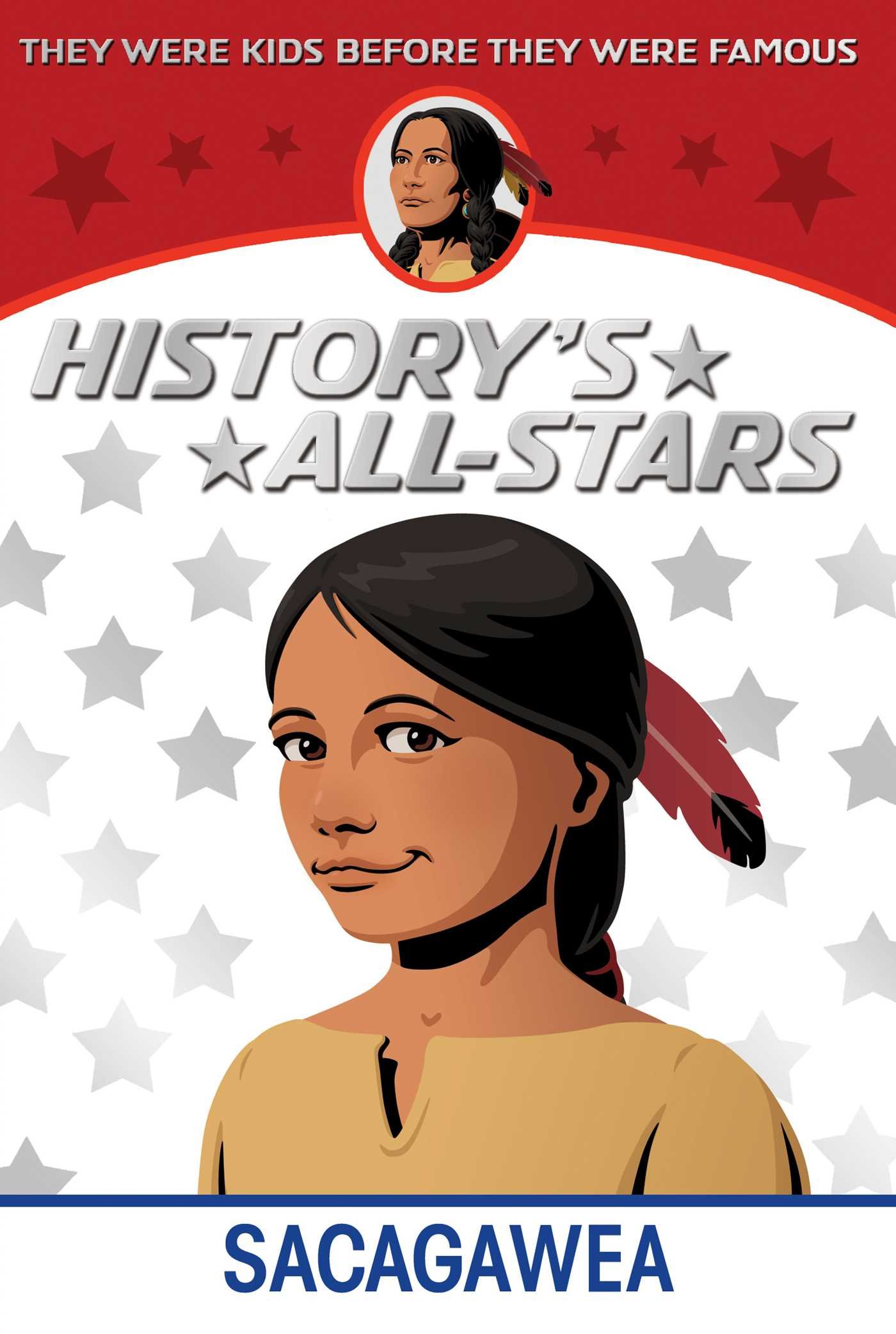
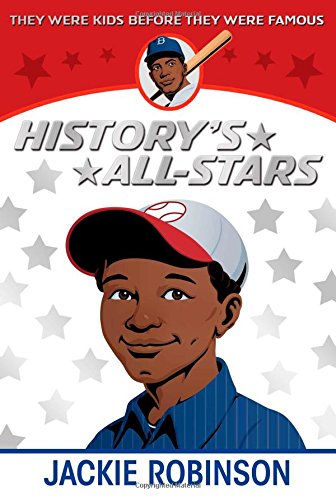
Look vaguely familiar? Pick up the book and you may find the words “Childhood of Famous American” in there individually, but never strung together in that particular order. The publication page only mentions that the books were previously published as far back as the 1950s (little wonder I’m worried about that Sacagawea title, yes). Yet the design, as you can see, isn’t far off so we had to wonder. Is it just the same series? A side-by-side comparison:


The publisher description calls this “a narrative biography” which is technically the accepted term for this kind of book. But there is no way you could use this for a report. They’re fiction, baby. A kind of fiction that doesn’t really have a designated place in a library collection at this time, though that could change. Which brings us to . . .
Ordinary People Change the World – A series by Brad Meltzer, illustrated by Christopher Eliopoulos
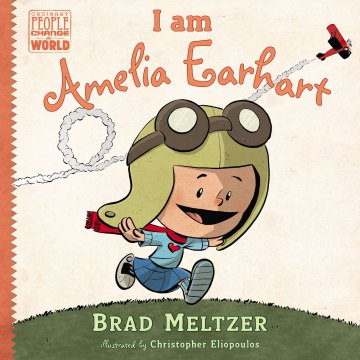
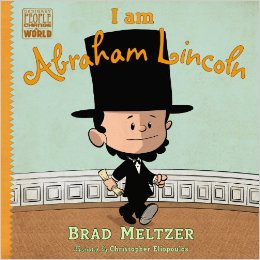
It’s the series bound to wreck havoc with catalogers everywhere! They look like Charles Schulz characters. They read like nonfiction . . . sorta? Kinda? Kirkus said of I Am Rosa Parks that it was, “A barely serviceable introduction with far more child appeal than substance.” Yet they’re bestsellers and visually incredibly appealing. Published by Dial (a Penguin imprint), the books were a risk that appears to have paid off in terms of dollars. In terms of sparking interest in these historical figures it’s also a success. But is it factual? Is it accurate? Does it stand up to scrutiny? Does it matter? Why shouldn’t it matter? You see the conundrum.
Finally, there’s a series coming out from Scholastic that looks like it might be along similar lines to these, but that I haven’t seen firsthand quite yet:


Called the When I Grow Up series, again we’re seeing historical figures as children. But maybe these are entirely accurate in their retellings? They’re Scholastic Readers, made to meet the needs of early readers. It’s the title “When I Grow Up” that raises the red flag for me. Because, you see, they’re written in the first person. And as a librarian who has had to field reference questions from first graders asking for “autobiographies”, this is problematic. If a book is entirely accurate but seems to come from the lips of its biographical subject, what is it worth in the pantheon of nonfiction?
People will always say that worrying along these lines is ridiculous. If the books are good and spark an interest, isn’t that enough? Why do you have to require strict accuracy at all times? My argument would be that when biographies are written for adults, people are meticulous (hopefully) about maintaining authenticity. Why should we hold our kids to different standards?
It’s a debate. These books just crack it open wide.
Along the same lines (WARNING: Shameless plug looming on the horizon!) I’ve gotten out the jumper cables and restarted the old Children’s Literary Salon at NYPL. Babies have been born and it is time to get back in the swing of things. On that note, on Saturday, September 6th I’ll be hosting one of children’s nonfiction all-stars in a conversation that might very well touch on this topic. Behold!
Personal Passions and Changes in Nonfiction for Children and Teens: A Conversation with Marc Aronson
Author, professor, speaker, editor and publisher by turns, Marc Aronson’s love of nonfiction and his conviction that young people can read carefully, examine evidence, and engage with new and challenging ideas informs everything he does. Join us for a conversation about the changing role of nonfiction for youth, and the special challenges and advantages of this one-of-a-kind genre.
See you there, yes?

Kate's Story, 1914. (Secrets of the Manor #2) Adele Whitby. 2014. Simon & Schuster. 160 pages. [Source: Library]I ended up reading the second book first in this series, Secrets of the Manor. But I do plan on going ahead and reading Beth's Story, 1914.
Beth and Kate are cousins. Kate is American. Beth is English. Beth is slightly older apparently. On her twelfth birthday, she received a super special heirloom necklace from her great-grandmother, I believe. Kate will be receiving her own super-special necklace on her twelfth birthday. Beth has traveled all the way across the ocean to be there! Well, her visit is to be for six to eight weeks or so. Was. But this is the summer of 1914. And things get tense after the assassination.
This book is all about the two girls, two cousins, meeting each other for the very first time. Kate has been waiting years and years to meet her cousin. She's beyond ecstatic to spend time with her. They've only corresponded before this. Beth seems just as enthusiastic to be best friends.
Secrets. These two thrive on secrets. The whole premise of the series is on secrets!
I liked this one. I will definitely go back and read the first book!
Beth's Story, 1914. (Secrets of the Manor #1) Adele Whitby. 2014. Simon & Schuster. 160 pages. [Source: Library]Secrets of the Manor is a new historical fiction series by Adele Whitby. The first book in the series is Beth's Story, 1914. The book introduces readers to Beth and her family. Readers learn that Beth is from a well-to-do family. When the novel opens, Beth is several days away from her twelfth birthday. Her twelfth birthday is apparently the most exciting, thrilling, wonderful thing ever. For that is the day she'll receive the Elizabeth necklace, an heirloom necklace worn by every Elizabeth in the family. The is also a Katherine necklace. Beth's cousin Kate, who lives in America, will receive her heirloom necklace on her twelfth birthday in a few months.
For Beth's birthday, her French cousin Gabrielle (15) and her maid Helena come to stay with the family. Beth really really wants her cousin to be a good friend. She's very eager to make a connection with her older cousin. Her older cousin, however, can barely conceal her indifference to Beth. Gabrielle is definitely the villain in this one!
Secrets. Beth discovers that her family has secrets. She takes her first steps to finding out what there is to know. Readers won't learn all the secrets in this first book of course!
© 2014 Becky Laney of
Becky's Book Reviews

By:
Betsy Bird,
on 6/12/2014
Blog:
A Fuse #8 Production
(
Login to Add to MyJacketFlap)
JacketFlap tags:
Reviews,
picture book,
picture books,
Simon and Schuster,
Atheneum,
Best Books,
funny picture books,
picture book readalouds,
Best Books of 2014,
Reviews 2014,
2014 picture book readalouds,
2014 picture books,
2014 reviews,
Add a tag
 Hug Machine
Hug Machine
By Scott Campbell
Atheneum (an imprint of Simon & Schuster)
$16.99
ISBN: 978-1-4424-593509
Ages 3-7
On shelves August 26th
Do you remember that old Shel Silverstein poem “Hug O’ War”? This may be considered sacrilege but did you ever notice how the guy could do something brilliant one moment, like “Sister For Sale” and then turn around and do something just doggone maudlin like “Hug O’ War” the next? Here’s a taste of what I mean: “Where everyone hugs / Instead of tugs / Where everyone giggles / And rolls on the rug”. You get the picture. The trouble is that hugs are hard. Adults love ‘em. Kids love ‘em. But writing about them inevitably drops you into sad saccharine territory where even great men like Silverstein find themselves inextricably mired in goo. It takes a sure and steady hand to navigate such territory. For that reason I think you need to take a close look at what Scott Campbell’s done with Hug Machine. There’s nothing wrong with writing a sweet picture book so long as it’s smart and/or funny. It’s harder than just pouring sugar in there and hoping people go along for the ride, which may explain why the market is glutted with schmaltz. Forget the “cute” picture books that make obvious overtures for your heartstrings. Opt instead for something that comes by its adorableness honestly. Hug Machine, man. It’s just the best.
Just call this kid a hugaphiliac. If there’s something out there he can wrap his arms around, he’s going to hug it. In fact, he’s so incredibly good at hugging that he has dubbed himself a “Hug Machine”. “No one can resist my unbelievable hugging,” says he, and he’s right. And what does the Hug Machine do on an average day? Well, it might hug everyone on the street. It might hug animals that are easy (turtles) and animals that are hard (porcupines). What does it eat? Pizza. And what does it hug? Everything! But when the day is done and the Hug Machine can hug no more, it takes a special set of arms to get the Hug Machine back in business again.
Some folks just take to the picture book form like a duck to water. I wish I could say that every cartoonist out there has the knack, but it just ain’t so. Many’s the time I’ve picked up a book from an artist I admired, hoping against hope that the transfer from adult to children’s books was seamless, only to find they just didn’t have what it took to speak to the small fry. Now the nice thing about Scott Campbell is that he’s sort of eased his way into the form. Under the name “Scott C.” he has penned many a grand book for grown-ups, like The Great Showdowns. Now we see his picture book authorial debut in Hug Machine. The verdict? I’m happy to report that all is well and right with the world. Here is a man who knows how to pack humor and heart all within a scant 40 pages.
This isn’t Campbell’s first time at the rodeo, of course. The man has tackled the wide and wonderful world of picture books before. If he wasn’t drawing romance stricken zombies on the one hand (Kelly DiPucchio’s Zombie in Love) then it was Bob Dylan lyrics (If Dogs Run Free) or, my personal favorite, dragons with conflict resolution issues (Robyn Eversole’s East Dragon, West Dragon). What do these all have in common? Probably just the simple fact that Campbell was doing the art on these books. Not the writing. And in at least one or two cases the art clearly outshone the texts. So how does he fare when he’s doing his own book? Magnificently, I’m happy to report. Because while I loved the art here, it was the text that made it work. Consider, for example, the section where The Hug Machine (there really isn’t any better term for him) encounters a porcupine. The porcupine laments, “I am so spiky. No one ever hugs me.” Turn the page and the boy has outfitted himself in a catcher’s mask, pillow on the middle, and oven mitts. The text reads, “They are missing out!” It is a wonderful phrase and not one you’d necessarily expect to see in a picture book. For whatever reason it reminded me of the wonderful wordplay of fellow picture book author/illustrator Bob Shea. To my mind it takes a special kind of talent to pluck just the right words out of the ether and to apply them at the perfect moment.
I mentioned earlier that Campbell, under the name of “Scott C.” created such amusing fare as The Great Showdowns. A bit of that aesthetic comes to mind when you check out the endpapers of this book. It necessitated an explanation to my three-year-old about what exactly a checklist is. You see, on the front endpapers of Hug Machine you see a range of different characters, each next to a little box. Turn to the back of the book and on these endpapers each character has been checked off. A child reader could easily spend hours matching each character to its appearance in the book. By the same token, kids could also have a great deal of fun just counting the number of hugs in this book in total.
I’ve little doubt that there will be an adult out there who is disturbed by the notion of a kid hugging complete strangers. I would point out, though, that we don’t actually know whether or not the people he’s hugging are strangers or not. For all we know he lives in a small town and is knows every person’s name, from the picnickers to the joggers to the construction workers. And that pretty much encapsulates any possible objections I could possibly find to the book. It would be an ideal readaloud for storytime (I’m jealous of the librarians and booksellers who will get to use it) to say nothing of reading it one-on-one. A real keeper. Share it with your own resident hug machine today.
For ages 3-6.
On shelves August 26th
Source: Galley sent from publisher for review.
Like This? Then Try:
Professional Reviews:
Other Reviews: The Early Career Committee of CBC


By:
Betsy Bird,
on 4/8/2014
Blog:
A Fuse #8 Production
(
Login to Add to MyJacketFlap)
JacketFlap tags:
Best Books of 2014,
Reviews 2014,
2014 reviews,
2014 biographies,
2014 nonfiction,
2015 Sibert contender,
2015 Caldecott contender,
Arun Gandhi,
Evan Turk,
Reviews,
nonfiction,
nonfiction picture books,
biographies,
Simon and Schuster,
Atheneum,
Best Books,
picture book biographies,
Bethany Hegedus,
Add a tag
 Grandfather Gandhi
Grandfather Gandhi
Arun Gandhi and Bethany Hegedus
Illustrated by Evan Turk
Atheneum (an imprint of Simon and Schuster)
$17.99
ISBN: 978-1-4424-2365-X
Ages 4-8
On shelves now.
Are you familiar with the concept of booktalking? It’s a technique librarians developed to get people interested in books they might otherwise not pick up. The whole concept is to develop a kind of movie trailer style talk that gives a sense of the book’s allure without giving up the plot. Typically booktalking is done for middle grade and young adult works of fiction, but enterprising souls have had a lot of luck with nonfiction as well. Now with an increased interest in nonfiction in our schools it’s more important than ever to make the books we hawk sound particularly good. It doesn’t hurt matters any when the books actually ARE good, though. Now let’s say I’m standing in front of a room of second and third graders with a copy of Grandfather Gandhi in my hands. How do I sell this book to them? Easy peasy. Some books practically booktalk themselves. Here’s how you sell it:
“Have any of you ever heard of Einstein? Yes? He’s the guy that was a total genius. Now imagine you’re his grandkid and you’re not that smart. Okay now, have any of you heard of the Beatles. Yes? Well imagine you’re one of THEIR grandkids . . . and you’re bad at music. Now here’s the big one. Has anyone heard of Gandhi? He was a great guy. He managed to free his country and stop a lot of oppression and he did it without any violence at all. Martin Luther King Jr. got some of his ideas from Gandhi about nonviolence. All right, well, now let’s image you are Gandhi, the most peaceful man IN THE WORLD’s grandson. What if you get mad? Can you imagine what it would be like to have everyone whispering every time you got a little steamed about something?”
So there you go. Quick. Simple. To the point. I’ve met a fair number of picture book memoirs in my day, but Grandfather Gandhi may well be my favorite. Smartly written with an unusual hook and art that will just knock your socks off, this is one title you are going to have to see firsthand for yourself.
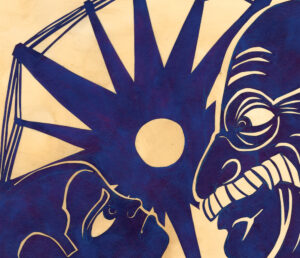 When young Arun and his family first arrive in his grandfather Mahatma Gandhi’s village, he’s mighty shy around his incredibly famous relative. Yet right away Grandfather is warm and welcoming to them, and when he praises Arun for walking the distance from the train station the boy swells with pride. Unfortunately, having Gandhi as your grandpa means having to share him with the 350 followers who also live in the village. Arun struggles with his lessons in Gujarati and the fact that there are no movie theaters around, but there are upsides to village life too. He’s pretty good at soccer with the other kids, and occasionally Grandfather will take him for a walk just mano a mano. But then, one fateful day, Arun gets into a skirmish on the soccer field and his anger is overwhelming. Shamed that the grandson of Gandhi himself would react in anger he confesses to his Grandfather immediately, only to find the man isn’t angry or disappointed in him in the least. Anger, Gandhi explains, is like lightning. You can use it to destroy or you can use it to light the world, like a lamp. Which will you choose?
When young Arun and his family first arrive in his grandfather Mahatma Gandhi’s village, he’s mighty shy around his incredibly famous relative. Yet right away Grandfather is warm and welcoming to them, and when he praises Arun for walking the distance from the train station the boy swells with pride. Unfortunately, having Gandhi as your grandpa means having to share him with the 350 followers who also live in the village. Arun struggles with his lessons in Gujarati and the fact that there are no movie theaters around, but there are upsides to village life too. He’s pretty good at soccer with the other kids, and occasionally Grandfather will take him for a walk just mano a mano. But then, one fateful day, Arun gets into a skirmish on the soccer field and his anger is overwhelming. Shamed that the grandson of Gandhi himself would react in anger he confesses to his Grandfather immediately, only to find the man isn’t angry or disappointed in him in the least. Anger, Gandhi explains, is like lightning. You can use it to destroy or you can use it to light the world, like a lamp. Which will you choose?
I think it’s fair to say that there have been a fair number of children’s picture books from family and relatives of famous peacemakers. Most notable would be Martin Luther King Jr.’s clan, where it sometimes seems like every son, daughter, niece, and nephew has his or her own spin on their infinitely famous relative. Gandhi’s a bit different. One wouldn’t expect his own descendants to have much in the way of access to the American publishing industry, so biographies of his life in picture book form have concentrated occasionally on his life and occasionally on The Great Salt March. When I saw that this book was co-authored by his fifth grandson I expected the same sort of story. A kind of mix of “this guy was fantastic” with “and I knew him!”. Instead, Hegedus and Gandhi have formulated a much more accessible narrative. Few children can relate to having a famous relative. But what about controlling their anger in the face of injustice? What’s fascinating about this book is that the authors have taken a seemingly complex historical issue and put it into terms so child-friendly that a five-year-old could get the gist of it. That Gandhi’s anger went on to become what spurned him to make lasting, important changes for his people is the key point of the book, but it takes a child’s p.o.v. to drill the issue home.
 Above and beyond all that, this is a book that advocates quite strongly for peace in all its myriad forms. Hardly surprising when you consider the subject matter but just the same I sometimes feel like “peace” is one of those difficult concepts without a proper picture book advocate. I went to a Quaker college where PAGS (Peace and Global Studies) was a popular major, and it was in making Quaker friends that I learned about picture books dedicated to the concepts embraced by that particular religion. Books like The Story of Ferdinand by Munro Leaf, The Table Where Rich People Sit by Byrd Baylor, Thy Friend, Obadiah by Brinton Turkle, and more. I’m sure that many is the Quaker household, or really any household that believes that peace is a practical and attainable solution, that will embrace Grandfather Gandhi as one of their own.
Above and beyond all that, this is a book that advocates quite strongly for peace in all its myriad forms. Hardly surprising when you consider the subject matter but just the same I sometimes feel like “peace” is one of those difficult concepts without a proper picture book advocate. I went to a Quaker college where PAGS (Peace and Global Studies) was a popular major, and it was in making Quaker friends that I learned about picture books dedicated to the concepts embraced by that particular religion. Books like The Story of Ferdinand by Munro Leaf, The Table Where Rich People Sit by Byrd Baylor, Thy Friend, Obadiah by Brinton Turkle, and more. I’m sure that many is the Quaker household, or really any household that believes that peace is a practical and attainable solution, that will embrace Grandfather Gandhi as one of their own.
It’s been a long time since I ran across a picture book with as long and lengthy a list of materials used in the illustrations as I have here. On the publication page it reads, “The illustrations for this book are rendered in watercolor, paper collage, cotton fabric, cotton, yarn, gouache, pencil, tea, and tin foil. Cotton hand spun on an Indian book charkha by Eileen Hallman.” Phew! You might think that all that “stuff” might yield something clogged up or messy, but that would be doing Mr. Turk a disservice. Observing how well he gives his pictures depth and texture, life and vitality, you might be shocked to learn that Grandfather Gandhi is his first picture book. From the spinning wheel endpapers to montages of sheer explosive anger, Turk makes a point of not only adhering to some of the more metaphorical aspects of the text, but finding new and creative ways to bring them to visual life. To my mind, the materials an artist uses in his or her art must, in the case of mixed media, have a reason for their existence. If you’re going to use “cotton fabric, cotton” and “yarn” then there should be a reason. But Turk clearly did his homework prior to doing the art on this book. He doesn’t just slap the images together. He incorporates the fibers Gandhi knew so well and turns them into an essential aspect of the book’s art. The art doesn’t just support the text here. It weaves itself into the story, becoming impossible to separate from the story.
 It’s Arun’s anger that proved to be the most visually interesting aspect, to me, in the book. Turk deftly contrasts the calm white thread produced by Gandhi’s spinning with the tangled black ones that surround and engulf his grandson whenever his feelings threaten to break free. The scene where he’s tempted to throw a rock at the boy who shoved him down is filled with thread, Arun’s magnificently clenched teeth, and black shadow figures that reach out across the field to the soccer net, dwarfing the three other little figures below. Later you can see the negative space found in cut paper turning from a representation of lightning into a thread of cotton in the hands of Gandhi illuminating a passage about making your anger useful. Yet Turk doesn’t just rely on clever techniques. He’s remarkably skilled at faces too. Arun’s expressions when he gets to see his grandfather alone or makes him proud are just filled with wide-eyed eager hope. And his frustrations and anger pulse off the page from his features alone.
It’s Arun’s anger that proved to be the most visually interesting aspect, to me, in the book. Turk deftly contrasts the calm white thread produced by Gandhi’s spinning with the tangled black ones that surround and engulf his grandson whenever his feelings threaten to break free. The scene where he’s tempted to throw a rock at the boy who shoved him down is filled with thread, Arun’s magnificently clenched teeth, and black shadow figures that reach out across the field to the soccer net, dwarfing the three other little figures below. Later you can see the negative space found in cut paper turning from a representation of lightning into a thread of cotton in the hands of Gandhi illuminating a passage about making your anger useful. Yet Turk doesn’t just rely on clever techniques. He’s remarkably skilled at faces too. Arun’s expressions when he gets to see his grandfather alone or makes him proud are just filled with wide-eyed eager hope. And his frustrations and anger pulse off the page from his features alone.
Picture books for kids about dealing with their anger tend towards the fictional. There’s Molly Bang’s When Sophie Gets Angry . . . Really Really Angry and Robie H. Harris’s The Day Leo Said, “I Hate You”. These are two of the good ones. Others veer towards the preachy and paternalistic. Imagine if you started using something like Grandfather Gandhi instead. More than just a memoir, the book offers a broad look at the benefits of channeling your anger. Better still, it’s a true story. Kids respect the true. They’ll also respect young Arun and his uncomfortable position. Fair play to author Bethany Hegedus for hearing him speak more than 13 years ago about this moment in his life, knowing that not only was there a picture book story to be had here, but a lesson kids today can grasp. As she says in her “Note from the Authors” at the end, “We world we live in needs to heal – to heal from the wars that are fought, to the bullying epidemic, to mass killings by lone gunmen, to poverty, to hunger, and to issues that contribute to internal anger being outwardly expressed in violent actions.” Gandhi’s message never grows old. Now we’ve a book that helps to continue his work for the youngest of readers. A necessary purchase then.
On shelves now.
Source: Final copy sent from publisher for review.
Like This? Then Try:
Other Blog Reviews:
Professional Reviews:
Interviews:
- ReaderKidZ speaks with Ms. Hegedus about the book.
- Meanwhile Kirkus interviewed the two authors and the illustrator here.
Misc: This is a book with a very nicely maintained and updated website of its own. Some of my favorite posts include this one from Evan Turk on how he got access to the spun cotton fiber featured in the book. I also light his piece on Light & Shadow and this one on how he chose his art. Arun even has posts up containing family Gandhi stories that would make an excellent follow up books should the need arise. Be sure to read the one on pumpkins and eggs when you get a chance.
Video:
One of the top best book trailers I’ve seen in a really long time. Accomplished and it does a brilliant job of highlighting Turk’s art.
llustration & Animation by Evan Turk
Voices: Arun Gandhi & Bethany Hegedus

.jpeg?picon=3655)
By: fishgirl182,
on 3/14/2014
Blog:
Read Now Sleep Later
(
Login to Add to MyJacketFlap)
JacketFlap tags:
dystopia,
young adult,
book review,
Simon and Schuster,
3 stars,
dystopian,
revolution,
kimberlybuggie,
bought,
end of series,
LaurenDestefano,
Add a tag
Publication date: 12 Feb 2013 by Simon & Schuster
Category: Young Adult DystopiaKeywords: Dystopia, End of series, RevolutionFormat: Hardcover, ebook, audiobookSource: PurchasedSynopsis:With the clock ticking until the virus takes its toll, Rhine is desperate for answers. After enduring Vaughn’s worst, Rhine finds an unlikely ally in his brother, an eccentric inventor named Reed. She takes refuge in his dilapidated house, though the people she left behind refuse to stay in the past. While Gabriel haunts Rhine’s memories, Cecily is determined to be at Rhine’s side, even if Linden’s feelings are still caught between them.
Meanwhile, Rowan’s growing involvement in an underground resistance compels Rhine to reach him before he does something that cannot be undone. But what she discovers along the way has alarming implications for her future—and about the past her parents never had the chance to explain.
In this breathtaking conclusion to Lauren DeStefano’s
Chemical Garden trilogy, everything Rhine knows to be true will be irrevocably shattered.
Kimberly's Review:This is a hard book for me to review because I loved Wither, the first book in The Chemical Garden trilogy, so much.
Without giving too much away, Rhine has escaped the mansion only to find herself at Reed's house, Vaughn's long estranged brother.
Searching for her twin brother, and trying to come to terms with her feelings for both Linden and Gabriel, Rhine embarks on a quest that will answer her questions once and for all. But not all the answers are what she wants them to be. And some of them she wishes she never knew.
I had a lot of problems with Rhine in this book. I loved her in the first two books- independent, strong willed and wanting nothing more than to survive and go home. And while this Rhine isn't that far from the old, she is slightly different. She's been through so much and she's very damaged by the events of the previous two books. But instead of making her more sympathetic, I felt more distant to her character. Her urgent need to find her brother, and then once she does eventually find him, she doesn't scream at him all of the evil she's encountered. (This will make sense once you read the book) I was so frustrated with her! She's also super confused about her feelings for Gabriel and Linden, which just became grating on me. I'll explain.
I am probably in the minority, but I have to say that I am probably on team Linden. Yes, he's pretty dense and should have been paying more attention to the evil that was his own father. But Linden's character grows exponentially during this final book and so by the end, I was hoping that she would end up with him. He was always my favorite of the two, between him and Gabriel and though the sister wife thing does creep me out, I still think Linden is the better choice. However, this of course proves problematic because he also has Cecily, his youngest wife still on his arm.
Cecily has also grown. In Fever, book two, the story took Rhine away from both of them and when she returns, they've both matured. While I can't say I like Cecily, I don't mind her and in fact, I may actually have respected her by the end.
What is strange is that Gabriel is mostly absent in book three. This is supposed to be her big love interest! It really hurt my feelings towards Gabriel because he was MIA for so long. I re-attached myself onto Linden. Sorry Gabriel, but even when you were the main character in Fever, I still wasn't a fan. I don't think you had a strong enough personality, and I never really understood what Rhine saw in you.
Now let's talk about Rowan. Rowan, the brother who Rhine is after. Rowan, who is barely a character at all in book three. I'm really sorry but I don't get it. There is nothing special about Rowan and as for their deep, twin relationship, I didn't feel it. He seemed like a secondary character that just appeared for plot sake. I wasn't emotionally invested in Rowan. She searched the country, confronted dangers and evil, for this guy?
I read books two and three right after the other and they move very fast. I love how the story flows so quickly you can get lost for hours in the world. Their world is scary, mean and unforgiving. There's a lot to like about The Chemical Garden trilogy. I love the freshness of the story and felt like the characters were always in real danger, just escaping by their skin. I love the big reveals during the end, including Rhine's revelation and Madame's secrets.
Overall, I enjoyed Sever and the entire series. While I didn't have a great sense of the characters or motivation behind them, the plot was fast and I wanted to know what happened next. I would recommend it for older YAs as well as adults looking for a dark dystopian.

The Boy on the Wooden Box by Leon Leyson. 2013. Simon & Schuster. 240 pages. [Source: Library]
Definitely loved this memoir! I would definitely recommend it to anyone interested in reading about the Holocaust. The story begins in the late 1930s in Poland, and continues on through the war to liberation. It is the story of a young boy and his family--many members were saved by Schindler, however, not all of them, for not all lived in the same community and had the same opportunities to come and work for Schindler. Still, it seems miraculous that so many of his immediate family WERE saved, and did survive the war despite all the horrors and hardships and unknowns. Leon Leyson's memoir is powerful and compelling, just what you'd expect. But it was also thoughtful and age-appropriate. It did a good job in providing details and experiences, grounding this very human story into history.
There was just something about it that I LOVED. He could reflect with love and affection on the people he loved and respected; he seemed to hold onto the good of his past, the little things and the not-so-little things that made his childhood what it was. He did this without negating the things that were painful and bitter and just as true. The narrative voice was so strong and wonderful in this one.
© 2014 Becky Laney of
Becky's Book Reviews
 Ghost Hawk
Ghost Hawk
By Susan Cooper
McElderry Books (an imprint of Simon & Schuster)
$16.99
ISBN: 978-1-4424-8141-1
Ages 9-12
On shelves now
How do we best honor our literary heroes? Particularly those who not only live but continue to produce works of fiction within our lifetimes. Like whole swaths of women and men my age, I grew up on Susan Cooper’s The Dark is Rising series when I was a child. And while I may not have understood everything the books were doing at the time, I liked them sincerely. Admittedly my maturity level made me a bigger sucker for her Boggart series, which was light and fluffy and lovely. When I grew up and became a children’s librarian I dutifully read books of hers like Victory which I enjoyed (and I reread those Dark Is Rising titles to actually get them this time around). All this is to say that I was always a fan. But as a fan, I don’t feel particularly inclined to coddle my heroes. The respect and, yes, awe that I feel for them should never blind me to the quality of their writings, even as they grow older. And while there is nothing about Ghost Hawk, the latest book by Ms. Cooper, that suggests that she is working in anything but her prime, I can say with certainty that if I had read it without knowing the author’s name I would have called you a dirty liar had you told me its true creator. A mismanaged, ultimately confusing work of historical fiction, this is a well-intentioned piece that suffers at the hands of an otherwise great author.
Little Hawk, member of the Pokanoket tribe of the Wampanoag Nation, is on the cusp of becoming a man. With only a bow and arrows and his own tomahawk, he sets out to survive the cold winter chill for three moons on his own. This he does after much trial and error, only to return to find his tribe felled by disease. After moving to a new tribe he experiences increased interactions with white settlers, and through them begins to befriend a boy by the name of John. When tragedy strikes, Little Hawk is there to guide John and help him learn unfamiliar ways.
Let me say right now that this is a spoilery review. A review so chock full of spoilers that should you wade in, even up to your ankles, you will soon find yourself facing huge discussions of the end of this book and the surprising plot points. I play fair. I warn you. But if you’re looking to read this book and you wish to remain shocked by its structural intricacies (such as they are) read no further.
To be clear, mine is not the first voice of dissent on this title. As it happens Ghost Hawk was a subject of much contention even before it was even published. Debbie Reese is tribally enrolled at Nambe Pueblo in northern New Mexico and currently works as an assistant professor in American Indian Studies at the University of Illinois at Urbana-Champaign. Ms. Reese raised a great many concerns with the text, and her point of view has been examined and argued and contested ever since. Now I will confess to you that this is not my own area of expertise. The likelihood of one name being used over another, or the ways in which someone actually goes about creating a tomahawk are unknown to me. This may be a debate that rages for some time, and I’ve no doubt that it shall. That said, I had my very own personal problems with Cooper’s text. Problems that had less to do with customs like when one gives tobacco to another, and more with the broader scope of the book itself. Take, for example, the Pokanoket tribe of the Wampanoag Nation. I wouldn’t go so far as to call them humorless, but Cooper imbues them with a stately majesty best suited to totems or symbols rather than people. Where is their humor? Where is their humanity? They live and die as representations, not humans. When Little Hawk returns to his village, you feel mildly bad for him but hardly crushed. You didn’t know these people, not really. They didn’t feel enough like people to you. So where’s the outrage? Where’s the anger?
Then there’s the fact that in his ghost form (more on that in a second), Little Hawk is capable of seeing the past and the present but not the future. This awfully convenient narrative technique is unworthy of an author of Cooper’s skill. It is a clunky choice. A more elegant method of introducing information that Little Hawk would not otherwise have would have been welcome. As it is, we’re stuck with an amusingly semi-omnipotent narrator.
These have been my problems with the book, certainly. But if we take another step back and simply look at the plot of the book in its roughest form, problems are immediately apparent. Here, then, is the plot. A Wampanoag boy named Little Hawk grows up and undergoes a trial to prove that he is a man. When he returns he finds his village dead. He grows up. He is killed (thus ends the first part of this book). He then is seen in ghost form by a white child settler named John. John learns the Algonquin language and customs through his friendship with Little Hawk’s ghost. At this point the reader is going to start wondering how John will use this knowledge. Will he be a bridge between communities? Will he use his valuable skills to solve problems no one else can?
Nope. He’ll grow up and be killed by a different Native American. Good night, everybody!!
I don’t think I’m the only one who read that passage in the book where John dies and came to the unavoidable conclusion that this book didn’t have much in a way of a point. Under normal circumstances, when a character acquires knowledge after a long period of time (not to mention a deeper understanding of another culture) they use it later in the story to the benefit of others. One could argue that John does use the knowledge when he saves Metacom from certain death, but this is not the case. John grabs the child and then is able to communicate with the parents later, but no real outcome is derived from this. Well, then maybe Cooper’s point is that there is no point. Maybe history is just a series of unfortunate events without rhyme or reason. Could be. But why even bother to take the time to build this friendship between a boy and a ghost if you’re just going to throw it away later? I cannot for the life of me figure out what Cooper was doing with this story.
Which brings us to the very end of the book. The moment when Susan Cooper herself decides to walk onto the page. We know from her Author’s Note that Ms. Cooper “built a house on Little Hawk’s island” seven years ago or so. This act served as one of the impetuses for writing this book in the first place. Lots of authors have found similar fonts of inspiration in their adopted homes. What they do not usually do is put themselves into the books as the ultimate Deus Ex Machina. In the case of “Ghost Hawk”, Ms. Cooper introduces Little Hawk to Rachel. She is “a woman, in her middle years. She has dark eyes and hair, and her name is Rachel. She is a painter. She appears to live alone.” Rachel’s purpose in this story is to free Little Hawk from his imprisonment. It is she that figures out what John and Little Hawk himself could not. She solves the mystery of his existence, he goes free, and that’s the end of the book. Above and beyond whether or not it’s kosher to end a book with a white woman swooping in to save the day one has to assume it’s a bit odd when the author places such a clear cut stand-in for themselves on the page. Again, the appearance of Rachel is clunky. I keep using that word but no other fits quite as well. It disrupts the book without need or reason.
Now here’s the kicker. For all that I moan and groan and rend my garments, you never once forget that Cooper is a great author. She knows how to construct a tale. Maybe a bit of judicious editing would not have been out of place (clocking in at 336 pages the removal of 50 or so could only have been to the good) but you’re never in doubt of the fact that the woman knows how to write. Amusingly, I’ve just gone back to my own dog-eared copy to find that I even highlighted some passages. One was a rather interesting description of how the wars with Spain ate up all the trees in England thanks to the efforts of the shipyards. It’s a fun moment, but then it’s a moment when we’ve returned to Cooper’s native land. Moreover, as I read through the book I noticed that the audience it really seems to be aimed towards is adults. Our hero Little Hawk spends very little time young. John himself grows with prodigious speed and then is a grown man seeking his way in the world. Are there many enticements for kids in this story? I think not.
There will be, I just know, a child out there assigned this book to read for school. The teacher will gaze with respect upon the author’s name and the words “Newbery Award-Winning Author of the Dark Is Rising” embedded on the book’s front cover. They may even seek out the reviews that praise it highly. PW called it “well-researched and elegant”, while Booklist gave it a star and said, “this is simply an unforgettable reading experience.” No argument there, but I think we differ slightly on what we deem “unforgettable”. Even Horn Book itself praised it to the skies with the words “powerful” and “memorable”. And so they shall assign this book to their fourth or fifth or sixth graders and it will become a book of required reading for many summers to come. The kids could read instead the expertly penned The Birchbark House by Louise Erdrich. They could delve into Helen Frost’s Salt: A Story of Friendship in a Time of War or Tim Tingle’s How I Became A Ghost or Rosanne Parry’s Written in Stone. But no. They will be assigned this and they will reach the ending saying precisely what I myself said: What precisely is the point? The point, it would seem, is that even a strong and talented writer who knows how to make a truly beautiful sentence does, occasionally, fall flat. This is not Cooper’s best effort. It is not even in her top ten. It is, however, historical American history. We’ll just have to agree to disagree on whether or not that trumps its other problems.
Other Reviews:
Other Critiques:







By: Kathy Temean,
on 4/16/2013
Blog:
Writing and Illustrating
(
Login to Add to MyJacketFlap)
JacketFlap tags:
Tracy Campbell,
Rachel Mannheimer,
Agent,
HarperCollins,
News,
Simon and Schuster,
authors and illustrators,
Publishing Industry,
Kudos,
Editor & Agent Info,
Publishers and Agencies,
Add a tag

Tracy Campbell sent in this April showers illustrations. She is a writer and an artist, living my dream. When she is not busy with her interior decorating business, she taps away on her laptop and writes for children, tweens, and teens. She also sharpens pencils, flips open paint lids, and yank off marker caps to draw and paint whimsical works of artfrom her second-floor studio in my 1841 farmhouse nestled high on a hill…assuming she doesn’t get distracted by howling coyotes marching up the gangway or by ribbon-streaked sunsets that take her breath away. She has a whimsical shop where she sell greeting cards, inspired by all things warm and fuzzy. To view my Premier Collection, pop on over to www.tracycampbell.net/shop.html.
At Bloomsbury, Rachel Mannheimer has been promoted to editor.
Tracy Sherrod will join Amistad as editorial director on April 22. Previously she was the founder and proprietor of Tracy Sherrod Literary Services, representing Karine Steffans, Katori Hall, Kalisha Buckannon, and others (and prior to that she was an editor at Simon & Schuster).
Amistad is a division of HarperCollins, who publishes works by and about people of African descent, on subjects and themes that have significant influence on the intellectual, cultural, and historical perspectives of a world audience.
At Simon & Schuster, Nick Greene has been promoted to associate editor and Jonathan Cox moves up to assistant editor.
At Workman Publishing, Raquel Jaramillo, who has been acting creative director for two years, will return full time to her position as director of children’s publishing.
Following on Avon Impulse and Harper Teen Impulse in the US, Harper UK will launch a digital first women’s fiction and romance imprint in May. Harper Impulse, an imprint of their Harper Fiction division, aims “to find, publish and break new talent from debut authors, and import the hottest trends from the US.” Harper Fiction publishing director Kimberley Young will run the line , joined by content developer Charlotte Ledger, who worked previously at Chawton House Library as well as Mills & Boon.
They invite unrepresented submissions and are looking for everything from “short reads to epic sagas.” The company says they have received hundreds of manuscripts over the past month and have three acquisitions in the works. and has already received nearly 500 manuscripts in less than a month and has three acquisition deals in the works. Their editorial team will offer writing workshops and events “to give authors a diverse publishing experience.”
Publishers Marketplace reports: After Skyhorse and Start Publishing’s intended joint acquisition of Night Shade Books’ assets ignited public controversy over the original terms of sale (and now, after a revision, the sale “is in a holding pattern right now waiting for all the authors’ feedback”, a Skyhorse spokesperson told us) the two publishers have bought a different science fiction & fantasy publisher, Underland Press, for an undisclosed sum. The deal for the six-year-old press, according to a joint release, is part of Skyhorse and Start Publishing’s plans “to deepen their relationship to the genre community.”
Skyhorse publisher Tony Lyons said in a statement: “We are thrilled at the acquisition of Underland. We look forward to publishing 10–20 new books a year.
Talk tomorrow,
Kathy
Filed under:
Agent,
authors and illustrators,
Editor & Agent Info,
Kudos,
News,
Publishers and Agencies,
Publishing Industry Tagged:
HarperCollins,
Rachel Mannheimer,
Simon and Schuster,
Tracy Campbell 



Oh, happy news! Loose Threads and On Pointe are released today as ebooks! Many thanks to my agent Elizabeth Harding and my publishing house Simon & Schuster. I appreciate their work in this venture. May both books wing into the hands of just the right readers.
To recap Loose Threads:
In a household of four generations of women, Grandma Margie discloses that she has a lump in her breast. Told through forthright and perceptive poems in teenager Kay's own voice, Loose Threads reverberates with emotion and depth and will leave no reader untouched. (flap copy)
Booklist named Loose Threads a Top Ten First Novel for Youth and gave it a starred review:
"Like Virginia Euwer Wolff's free verse novels, Grover's book balances vivid emotional scenes with plenty of space between the words. Readers, especially those who know illness up close, will connect with Kay's secret worries and deep sadness, and will admire her strength."
The work was also a Washington State Book Award finalist, a New York Public Library Book for the Teen Age, a Bank Street College Best Children's Book of the Year, and a Rhode Island Teen Book Award Nominee.
And to review On Pointe:
On Pointe soars with emotion as it explores what it means to reach for a dream -- and the way that dreams can change as quickly and suddenly as do our lives. Clare learns to dream and then dream again.
On Pointe was a Girls Life Top Ten Summer Read.
"The teen's voice rings true. This finely written novel touches on contemporary themes such as body image leading to bulimia, overly ambitious parents, and aging grandparents who can no longer live alone." School Library Journal
The work was also a Dorothy Canfield Fisher Award Nominee and a Bank Street College Best Children's Book of the Year.
Thanks for celebrating with me today and helping to spread the news. With my love!
Loose Threads
On Pointe
Simon & Schuster, 2013, ebook release

Putting great books into the hands of young readers is something Alexandra Penfold has been doing for the last decade, and now she’s doing it wearing a new and very dashing hat.
Alexandra’s career trajectory is a bit different from most editors, she was a business major in school and did a bunch of different internships including interning for the writers' office of
All My Children. From there, Alex enjoyed working with Tracy van Straaten, who at the time was in publicity at Simon & Schuster. And Tracy’s awesomeness inspired Alex to jump into a career in children’s book publicity at S&S. Alexandra then transitioned into the editor role at
S&S with Paula Wiseman, and for eight years she had a blast there.
Now she’s a newly minted agent at
Upstart Crow Literary and her afternoon session is excited to hear what she’s looking for as she starts to build her client list of picture book makers, and middle grade and YA authors.
Alex wishes there was a magical formula to tell us what makes an irresistible book, but there isn’t one.
Which is bad news, but because there’s no magic formula, good news! Alex doesn’t like to poopoo any genre or category, she's open to being surprised by books she never imagined she’d acquire or represent. The only exception to that is high fantasy, she’s still not into it, no matter how much Tolkein her husband reads to her, sorry, Bilbo.
Alex explains to the group the ins and outs of acquisitions from an editor’s point of view: an editor is putting their reputation on the line every time they bring a book to an acquisitions meeting. It's an investment on all levels and as an agent, Alex will still only represent books she loves wholeheartedly and will fight for.
One of the many lovely tips Alex left us with was the paramount importance of great characters in your work, knowing them inside and out. If you see Alex this weekend and want to get into a heavy discussion, just ask her if Scarlett and Rhett eventually get back together after The End of
Don't forget to follow Alexandra Penfold on Twitter
@AgentPenfold

By: Kathy Temean,
on 12/17/2012
Blog:
Writing and Illustrating
(
Login to Add to MyJacketFlap)
JacketFlap tags:
Eilzabeth Rose Stanton,
Little Brown Heather Fain,
Agent,
Editors,
Simon and Schuster,
authors and illustrators,
Kudos,
Melissa Sarver,
Folio Literary,
Liz Van Doren,
Add a tag
 Elizabeth Rose Staton has good news! She has been offered a contract for her first picture book! HENNY, a story about a young chick who is born just a little different from everyone else in the barn, and learns how to use her special gift to come into her own.
Elizabeth Rose Staton has good news! She has been offered a contract for her first picture book! HENNY, a story about a young chick who is born just a little different from everyone else in the barn, and learns how to use her special gift to come into her own.
Elizabeth completed the artwork (pencil and watercolor) this past October, and the book is slated to be released early in 2014 (Simon & Schuster/Paula Wiseman Books).
I asked Elizabeth about the story behind how she landed the contract. This is what she said:
Everything about it happened very quickly…I think my head is still spinning! I attended the SCBWI conference last January in New York, and participated in the portfolio show. A New York agent picked up one of my cards and phoned me about a week after I got home. We discussed my work, and what I was working on (“Henny”) and, next thing I knew, she offered me representation! Just about the time “Henny” was ready for my agent to shop, our regional (Western Washington) conference rolled around. I asked my agent if it would be a good idea for me to take the dummy to the conference and she said, go for it! Long story short, one of the conference faculty, an art director for Simon & Schuster, saw Henny, and the next thing I knew S & S had called my agent and offered me a book deal! I might add… all this was going on around the time of my Illustrator Saturday feature, and I am sure it helped with my “credibility!”  So, as you can see, I am totally an SCBWI success story! It has all been such a fun, whirlwind experience and I am really looking forward to getting another book out there
So, as you can see, I am totally an SCBWI success story! It has all been such a fun, whirlwind experience and I am really looking forward to getting another book out there 
Here is a sneak peak at a piece of interior art from Henny:
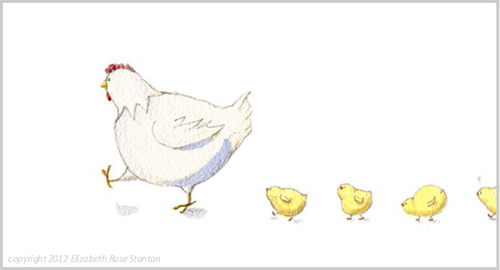
Melissa Sarver ( you might have met her at the conference in June) has joined Folio Literary Management as the co-director of international rights and will continue to represent authors in the areas of Young Adult, select literary and upmarket adult fiction, narrative non-fiction, business books and cookbooks. She was previously at The Elizabeth Kaplan Literary Agency.
At Little, Brown, Heather Fain has been promoted to associate publisher, in addition to her ongoing duties as marketing director.
Liz Van Doren has been promoted to editorial director, book publishing at Highlights for Children and Boyds Mills Press.
At Orion, Jane Sturrock has been promoted to editorial director, non-fiction.
Congratulations to all!
Talk tomorrow,
Kathy
Filed under:
Agent,
authors and illustrators,
Editors,
Kudos Tagged:
Eilzabeth Rose Stanton,
Folio Literary,
Little Brown Heather Fain,
Liz Van Doren,
Melissa Sarver,
Simon and Schuster 

The Dragon's Apprentice. James A. Owen. 2010. Simon & Schuster. 376 pages.
The series has remained entertaining, but it's so complex now! Time has been unraveled--the Keep of Time is no more--and both worlds are in great danger, not particularly from the Winter King, but from a darker, more ancient Evil. The Caretakers have lost the ability to travel in time AND the ability to travel to the Archipelago. Both worlds are in danger, the Archipelago perhaps will experience the danger first, but, in the end the real world faces the threat of overwhelming darkness too. This adventure has the team of Caretakers (plus a varied assortment of talking animals) traveling through the one remaining door from the Keep of Time, the door that Madoc traveled through in the previous book, and spending a great amount of time in the 1760s. (Meeting Daniel Defoe, Benjamin Franklin, etc.) Can time be restored? Can darkness be defeated?
I am still enjoying this series. This book is the result of a whole series of consequences. For every previous decision, readers are now witnessing the full consequences of every person's actions and decisions. And I think it may also be the darkest or bleakest of the series. I can't wait to begin the newest book in the series, The Dragons of Winter.
Read The Dragon's Apprentice
- If you're a fan of the series. If you've read Here There Be Dragons, Search for the Red Dragon, Indigo King, Shadow Dragons.
- If you're a fan of fantasy, mythology, and classic literature
- If you enjoy mystery, adventure, and espionage with your fantasy
© 2012 Becky Laney of
Becky's Book Reviews
The Shadow Dragons. James A. Owen. 2009. Simon & Schuster. 417 pages.
The Shadow Dragons is my last in the series to reread. The next two books will be new to me! I am still enjoying this series, enjoying the characters and all the twists and turns. Each book leads the Caretaker into a bigger mess, making earlier conflicts seem almost too easy to set right. In this one, "to save the world" the Caretakers must team up with previous Caretakers and loyal subjects/citizens of the Archipelago. There are many separate journeys in this one--the Caretakers split up--and some will venture to the end of the world and back. One of their allies is Don Quixote! Madoc plays a significant role in this one--as does Rose. This book seems to be taking the series in a new direction. I did appreciate this one more upon rereading it. When I first read it, I had not read Don Quixote for myself. And I did not truly know his story well enough to appreciate his appearance in this series. I don't think you *have* to have read certain books in order to like the series, but, I do think your appreciation will only grow the more you know your mythology, classics, and fantasy novels. This one is still heavily reliant on King Arthur!!! Read The Shadow Dragons- IF you have enjoyed the previous books in the series: Here There Be Dragons, Search for the Red Dragon, Indigo King.
- If you enjoy fantasy, mythology, and classic literature
- If you enjoy works by C.S. Lewis and J.R.R. Tolkien
© 2012 Becky Laney of
Becky's Book Reviews
The Indigo King. James A. Owen. 2008. Simon & Schuster. 375 pages.
The third adventure in the series mainly features Jack and John...Charles being conveniently away when this unexpected challenge/adventure finds them. Hugo Dyson, a friend, is introduced to readers, when he is thrown into the adventure. He may not know where he is or why he's there, but, he is perhaps *safer* than Jack and John...at least temporarily. For after Hugo disappears through the mystery-door-that-appears-out-of-nowhere, and that mystery door is shut by some well-meaning animals from the Archipelago of Dreams, their whole world changes...for the worse. The "real world" is dark and dangerous and ruled by the Winter King. The two aren't without some hope, they discover their good friend, Bert, who has been waiting and waiting for them. And he gives them hope, a time machine of Jules Verne and a mystery box. These friends, these caretakers, will have to journey through time--observing things very carefully--and have to use some wisdom and discretion on what to change and what not to change. Can they "fix" time and save the world? While the second adventure used Peter Pan and Jason and Medea for inspiration, this one uses King Arthur and Odysseus and the Trojan War. It also is the novel that introduces the young woman, Rose, and a young man Hank Morgan. I really do LOVE this series!!! It is so fun to visit with these characters, and it's always interesting to meet new characters and see where they are going to take the story! This is a very significant book in the series, for it reveals the identity of the cartographer 'stuck' in the Keep of Time AND it reveals the identity of the Winter King.
This is also the book in the series that utilizes time travel most.
Read The Indigo King
- If you're a fan of fantasy, mythology, classic literature
- If you enjoy time travel; the more you LOVE time travel, the more you may appreciate this one!
- If you enjoy mystery and adventure mixed in with your fantasy
- If you've enjoyed the previous books in the series: Here There Be Dragons, The Search for the Red Dragon.
© 2012 Becky Laney of
Becky's Book Reviews
Here There Be Dragons. James A. Owen. 2006. Simon & Schuster. 326 pages.
I was a little nervous to reread Here There Be Dragons by James A. Owen. I remember just loving it when I read it the first time. Would I still enjoy it? Still find the characters enjoyable? The plot twists clever? I was not disappointed. In this first adventure, readers meet Jack, Charles, and John, the three caretakers of the Imaginarium Geographica. They meet Bert, a former caretaker as well. Readers are introduced to a few other key characters as well: Tummler, Aven, Bug, Samaranth, the Cartographer, the Winter King, Magwitch, etc. (Just to name a few.) Many stories, tales, and myths are hinted at in this one. But. Mainly this book serves as a fun introduction into a brand new fantasy series. Readers are introduced to the 'real' world (England 1917 or 1918) and the 'imaginary' world of the Archipelago of Dreams, a world where there are dragons and dragon ships, elves, trolls, and talking animals. Readers also learn about the Keep of Time, which is central to the series....
I loved this one! I thought the storytelling was great! Read Here There Be Dragons
- If you enjoy fantasy and/or mythology
- If you like dragons and other 'imaginary' creatures
- If you have enjoyed the works of C.S. Lewis, J.R.R. Tolkien, etc.
- If you love to read; this series draws richly from literature
© 2012 Becky Laney of
Becky's Book Reviews

By:
Becky Laney,
on 11/14/2012
Blog:
Becky's Book Reviews
(
Login to Add to MyJacketFlap)
JacketFlap tags:
YA Fiction,
series,
YA Historical Fiction,
time travel,
Simon and Schuster,
Margaret Peterson Haddix,
YA Science Fiction,
2012,
library book,
Books reviewed in 2012,
Add a tag
Caught. (Missing #5) Margaret Peterson Haddix. 2012. Simon & Schuster. 352 pages.
I have enjoyed Margaret Peterson Haddix's time-travel series for middle grade. Some of the books I've liked better than others, but, for the most part, I've enjoyed each one. In this fifth adventure, Jonah and Katherine face their biggest challenge so far. The book begins with the freezing of time. Jonah and Katherine are in school when time freezes. They know that something must have happened, but when and where?! They seek out others who have traveled in time--the only people unaffected so it seems by frozen time--but before they get the chance to do anything, Jonah and Katherine find themselves falling through time and landing in 1903. They have a few clues, they know Albert Einstein and his wife are somehow connected to their being there. But for the most part, these two are clueless and choosing to be invisible for as long as possible...but Albert Einstein's wife is clever and knows something is up....
Caught is a fast-paced read. I don't enjoy this series because the characters are well-developed and fascinating. I enjoy this series because of the story, the action, the history. I enjoy learning about different periods of history. I enjoy the author's notes at the end of each book. I like learning what is truth and what is fiction. I enjoy the time travel aspect of the story and the mystery behind it.Read Caught- If you've enjoyed the other titles in the Missing series by Margaret Peterson Haddix
- If you enjoy middle grade science fiction with a time travel element
- If you enjoy children's books with action and mystery
© 2012 Becky Laney of
Becky's Book Reviews

By:
Betsy Bird,
on 11/1/2012
Blog:
A Fuse #8 Production
(
Login to Add to MyJacketFlap)
JacketFlap tags:
Uncategorized,
middle grade fiction,
fantasy,
middle grade fantasy,
steampunk,
Simon and Schuster,
National Book Award,
Margaret K. McElderry,
2012 reviews,
Best Books of 2012,
2012 middle grade fiction,
William Alexander,
2012 middle grade fantasy,
middle grade steampunk,
Add a tag
 Goblin Secrets
Goblin Secrets
By William Alexander
Margaret K. McElderry Books (an imprint of Simon & Schuster)
$16.99
ISBN: 978-1-442434523
Ages 9-12
On shelves now
I think it is time to declare the birth of the clockwork children’s novel. If you have been watching the literary trends over the last decade or so, you will note that amongst adults there has been a real rise in interest in a form of pop culture labeled “Steampunk”. The general understanding is that as the 21st century grows increasingly reliant on electronics, there is a newfound interest in books/movies/video games/costumes (etc.) that incorporate steam, gears, and other accoutrements of the visual mechanical past. This is, I should note, almost exclusively an adult fascination. I have never encountered a single child who walked up to a reference desk and asked, “Do you have any more Steampunk?” That said, there’s no reason it shouldn’t work as a genre. The trouble comes when an author tries to shoehorn a Steampunk story into a fantasy mold. The best writers know that if you’re going to incorporate odd mechanical details, the best thing to do is to set up your own odd mechanical internal logic. I think that’s probably what I like best about William Alexander’s “Goblin Secrets”. It’s not the first story I’ve read about a boy joining a troupe of traveling performers. And it’s not the first middle grade Steampunk adventure I’ve come across. Yet there’s something definitely one-of-a-kind going on in this book. An originality that you only find once in a pure blue moon. And that’s worth reading, you betcha.
Rownie’s life hasn’t been worth much since the disappearance of his older brother Rowan. Living with “grandmother”, an old witch named Graba who holds a Fagan-like power over the orphans in her sway, Rownie runs various errands until one day he finds that goblins have come to his city of Zombay. They are conducting theatrical performances, an act forbidden to humans, so it’s as much a surprise to Rownie as to anyone when he joins their little troupe. Rownie is also still determined to track Rowan down, but that may mean using extraordinary means to escape from Graba’s all-knowing, all-seeing ways.
It’s little wonder that the book was nominated for a National Book Award when you take into account the writing. In terms of description, the book has a wonderful and well-developed sense of place. At one point this is what you read, “All roads to the docks ran downhill. They wound and switchbacked across a steep ravine wall, with Southside above and the River below. Some of these streets were so steep narrow that they had to be climbed rather than walked on. Stairs had been cut into the stone or built with driftwood logs lashed together over the precarious slope.” With a minimal amount of words you get a clear sense of the location, its look, its feel, its dangers, and perhaps its beauties as well.
The details found within this strange Steampunk world are delicious, and that is in the book’s favor. You hear about “small and cunning devices that did useless things beautifully.” From gears in mechanical glass eyes to the fact that a river is something that can be bargained with, there’s an internal logic at work here that is consistent, even if Alexander is going to leave the learning of these rules up to the reader with minimal help. For example, there is the small matter of hearts and their removal. To take out a heart is not a death sentence for a person, but it can leave them somewhat zombiefied (the city’s name “Zombay” could just be a coincidence or could not, depending on how you want to look at it). And goblins aren’t born but are changed humans. Why are they changed and for what reason? That’s a story for another day, but you’re willing to wait for an answer (if answer there ever is).
Exposition. It can be a death knoll in a book for kids. Done well it sucks the reader into an alternate world the like of which they may never have seen before. Done poorly they fall asleep three pages in and you’ve lost them forever. And done not at all? That’s a risk but done right it pays off in fine dividends. “Goblin Secrets” takes place in Zombay, a fact you find out five pages in. It’s a city that contains magic, a fact you find out on page three. There are goblins in this world (page twelve) but they didn’t start out as goblins (page . . . um . . .). Facts are doled out at a deliberate but unexpected pace in this book. There are no long paragraphs of explanation that tell you where you are and what to expect. It’s only by reading the story thoroughly that you learn that theater is forbidden, Rownie’s brother is missing, Graba is relentless (but not the only villain in the story), and masks are the book’s overriding theme. In the interest of brevity Alexander manages to avoid exposition with something resembling long years of practice. Little wonder that he’s published in multiple magazines and anthologies on the adult fantasy (not that kind) side of things. Many is the adult writer who switches to writing for children that dumbs down the narrative, giving too little respect to the young audience. I think Mr. Alexander’s gift here is that he respects his younger readers enough to grant them enough intelligence to follow along.
Alexander makes his own rules with this book, and not rules I’ve necessarily seen before. With that in mind, with as weird a setting as you have here, it can be a relief to run across characters you like and identify with. They act as little touchstones in a mad, crazy world. Rownie is particularly sympathetic right from the get-go. He has a missed beloved older brother, an independence that’s appealing, but he’s not a jerk or anything. Nor is he a walking blank slate that more interesting characters can use to their own ends. Rather, Rownie is the kind of character who keeps trying to talk himself into bravery. He does it when performing and he does it on his own (“Rownie tried to summon up the feeling that he was haunting the Southside Rail Station and that other sorts of haunting things should be afraid of him…”). That’s why Alexander’s use of masks and theater is so effective. If you have a protagonist who just needs a little push to reach his potential, what better way than through performance? On the flipside, the bad guys are nice, if perhaps a little two-dimensional. Graba is nothing so much as a clockwork Baba Yaga, mechanical chicken legs and all. By extension the Mayor is a good power hungry villain, if stock and staid. There is no big bad in this book quite worthy of the good folks they face down. Graba comes close, but she’s just your typical witch when all is said and done. A little gearish. A little creaky. But typically witchy, through and through.
By turns beautiful and original, it’s a testament to Alexander’s skills that the book clocks in at a mere 200-some odd pages. Usually worlds of this sort end up in books with five hundred or six hundred pages. The end result is that when a kid is looking for a good fantasy in a new world, they are inclined to be scared off by the thick tomes gathering dust on library shelves and instead will find friends in old classics like The Black Cauldron or The Lion, the Witch and the Wardrobe. Add to that list William Alexander’s latest then. A smart piece of writing that conjures up a new world using a new method.
On shelves now.
Source: Galley sent from publisher for review.
Like This? Then Try:
Last Line: “His fingers twitched and his mouth watered, but he waited for his supper to cool.”
Notes on the Cover: The unfortunate hardcover will happily be replaced with a far more kid-friendly paperback. As you can see, the previous incarnation showed a Frankenstein’s monster-esque goblin juggling. Alas the shot made it look as if the lit torch in hand was impaling him. It was a bit of odd CGI. The new cover is a traditional illustration and show Rownie hiding from his possessed former bunkmates. If I were to go with a good cover seen I might go with fighting the possessed masks, but I suspect they wanted to avoid the goblins entirely with this particular jacket.

Other Blog Reviews:
Professional Reviews:
Interviews:
Misc:
- Good news for fans. The sequel, Ghoulish Song, is already scheduled to be released next year. Happiness all around.

By:
Betsy Bird,
on 10/31/2012
Blog:
A Fuse #8 Production
(
Login to Add to MyJacketFlap)
JacketFlap tags:
Uncategorized,
middle grade fiction,
fantasy,
middle grade fantasy,
steampunk,
Simon and Schuster,
National Book Award,
Margaret K. McElderry,
2012 reviews,
Best Books of 2012,
2012 middle grade fiction,
William Alexander,
2012 middle grade fantasy,
middle grade steampunk,
Add a tag
 Goblin Secrets
Goblin Secrets
By William Alexander
Margaret K. McElderry Books (an imprint of Simon & Schuster)
$16.99
ISBN: 978-1-442434523
Ages 9-12
On shelves now
I think it is time to declare the birth of the clockwork children’s novel. If you have been watching the literary trends over the last decade or so, you will note that amongst adults there has been a real rise in interest in a form of pop culture labeled “Steampunk”. The general understanding is that as the 21st century grows increasingly reliant on electronics, there is a newfound interest in books/movies/video games/costumes (etc.) that incorporate steam, gears, and other accoutrements of the visual mechanical past. This is, I should note, almost exclusively an adult fascination. I have never encountered a single child who walked up to a reference desk and asked, “Do you have any more Steampunk?” That said, there’s no reason it shouldn’t work as a genre. The trouble comes when an author tries to shoehorn a Steampunk story into a fantasy mold. The best writers know that if you’re going to incorporate odd mechanical details, the best thing to do is to set up your own odd mechanical internal logic. I think that’s probably what I like best about William Alexander’s “Goblin Secrets”. It’s not the first story I’ve read about a boy joining a troupe of traveling performers. And it’s not the first middle grade Steampunk adventure I’ve come across. Yet there’s something definitely one-of-a-kind going on in this book. An originality that you only find once in a pure blue moon. And that’s worth reading, you betcha.
Rownie’s life hasn’t been worth much since the disappearance of his older brother Rowan. Living with “grandmother”, an old witch named Graba who holds a Fagan-like power over the orphans in her sway, Rownie runs various errands until one day he finds that goblins have come to his city of Zombay. They are conducting theatrical performances, an act forbidden to humans, so it’s as much a surprise to Rownie as to anyone when he joins their little troupe. Rownie is also still determined to track Rowan down, but that may mean using extraordinary means to escape from Graba’s all-knowing, all-seeing ways.
It’s little wonder that the book was nominated for a National Book Award when you take into account the writing. In terms of description, the book has a wonderful and well-developed sense of place. At one point this is what you read, “All roads to the docks ran downhill. They wound and switchbacked across a steep ravine wall, with Southside above and the River below. Some of these streets were so steep narrow that they had to be climbed rather than walked on. Stairs had been cut into the stone or built with driftwood logs lashed together over the precarious slope.” With a minimal amount of words you get a clear sense of the location, its look, its feel, its dangers, and perhaps its beauties as well.
The details found within this strange Steampunk world are delicious, and that is in the book’s favor. You hear about “small and cunning devices that did useless things beautifully.” From gears in mechanical glass eyes to the fact that a river is something that can be bargained with, there’s an internal logic at work here that is consistent, even if Alexander is going to leave the learning of these rules up to the reader with minimal help. For example, there is the small matter of hearts and their removal. To take out a heart is not a death sentence for a person, but it can leave them somewhat zombiefied (the city’s name “Zombay” could just be a coincidence or could not, depending on how you want to look at it). And goblins aren’t born but are changed humans. Why are they changed and for what reason? That’s a story for another day, but you’re willing to wait for an answer (if answer there ever is).
Exposition. It can be a death knoll in a book for kids. Done well it sucks the reader into an alternate world the like of which they may never have seen before. Done poorly they fall asleep three pages in and you’ve lost them forever. And done not at all? That’s a risk but done right it pays off in fine dividends. “Goblin Secrets” takes place in Zombay, a fact you find out five pages in. It’s a city that contains magic, a fact you find out on page three. There are goblins in this world (page twelve) but they didn’t start out as goblins (page . . . um . . .). Facts are doled out at a deliberate but unexpected pace in this book. There are no long paragraphs of explanation that tell you where you are and what to expect. It’s only by reading the story thoroughly that you learn that theater is forbidden, Rownie’s brother is missing, Graba is relentless (but not the only villain in the story), and masks are the book’s overriding theme. In the interest of brevity Alexander manages to avoid exposition with something resembling long years of practice. Little wonder that he’s published in multiple magazines and anthologies on the adult fantasy (not that kind) side of things. Many is the adult writer who switches to writing for children that dumbs down the narrative, giving too little respect to the young audience. I think Mr. Alexander’s gift here is that he respects his younger readers enough to grant them enough intelligence to follow along.
Alexander makes his own rules with this book, and not rules I’ve necessarily seen before. With that in mind, with as weird a setting as you have here, it can be a relief to run across characters you like and identify with. They act as little touchstones in a mad, crazy world. Rownie is particularly sympathetic right from the get-go. He has a missed beloved older brother, an independence that’s appealing, but he’s not a jerk or anything. Nor is he a walking blank slate that more interesting characters can use to their own ends. Rather, Rownie is the kind of character who keeps trying to talk himself into bravery. He does it when performing and he does it on his own (“Rownie tried to summon up the feeling that he was haunting the Southside Rail Station and that other sorts of haunting things should be afraid of him…”). That’s why Alexander’s use of masks and theater is so effective. If you have a protagonist who just needs a little push to reach his potential, what better way than through performance? On the flipside, the bad guys are nice, if perhaps a little two-dimensional. Graba is nothing so much as a clockwork Baba Yaga, mechanical chicken legs and all. By extension the Mayor is a good power hungry villain, if stock and staid. There is no big bad in this book quite worthy of the good folks they face down. Graba comes close, but she’s just your typical witch when all is said and done. A little gearish. A little creaky. But typically witchy, through and through.
By turns beautiful and original, it’s a testament to Alexander’s skills that the book clocks in at a mere 200-some odd pages. Usually worlds of this sort end up in books with five hundred or six hundred pages. The end result is that when a kid is looking for a good fantasy in a new world, they are inclined to be scared off by the thick tomes gathering dust on library shelves and instead will find friends in old classics like The Black Cauldron or The Lion, the Witch and the Wardrobe. Add to that list William Alexander’s latest then. A smart piece of writing that conjures up a new world using a new method.
On shelves now.
Source: Galley sent from publisher for review.
Like This? Then Try:
Last Line: “His fingers twitched and his mouth watered, but he waited for his supper to cool.”
Notes on the Cover: The unfortunate hardcover will happily be replaced with a far more kid-friendly paperback. As you can see, the previous incarnation showed a Frankenstein’s monster-esque goblin juggling. Alas the shot made it look as if the lit torch in hand was impaling him. It was a bit of odd CGI. The new cover is a traditional illustration and show Rownie hiding from his possessed former bunkmates. If I were to go with a good cover seen I might go with fighting the possessed masks, but I suspect they wanted to avoid the goblins entirely with this particular jacket.

Other Blog Reviews:
Professional Reviews:
Interviews:
Misc:
- Good news for fans. The sequel, Ghoulish Song, is already scheduled to be released next year. Happiness all around.
Vessel. Sarah Beth Durst. 2012. Simon & Schuster. 424 pages.
Vessel is a good example of an almost book for me. It almost almost made me love it, but, not quite. I did enjoy it, for the most part. There were chapters that were quite satisfying, that gave me hope. But then there were places I felt a disconnect, and ultimately I didn't end up loving it as much as I had originally hoped. I definitely went into this one with high expectations. I thought it had the potential to be wow-worthy. And I think for some readers, it works well, really well. I am sure it will find readers that do love it.
Readers first meet Liyana, a young woman who is destined to be a "vessel" to her clan's goddess, Bayla. When the possession does not happen, when the goddess fails to come and take possession of this girl's body, well, her clan leaves her to die in the desert. She doesn't die, however, she is found by a god, Korbyn, a trickster god who has recently taken possession of his own human vessel. He has a message and a mission. Certain gods and goddesses have vanished from the Dreaming, including Bayla. The ceremonies have failed and the gods and goddesses are disappearing. He doesn't know where, though he tells her he felt a pull to the East, but he knows that they have to rescue them from false vessels and restore them to their worthy (human) vessels. For only if they are restored will the god's magic be able to heal the desert lands and save all the desert clans. Liyana is easy to convince; she finds Korbyn charming and swoon-worthy. But some of the other vessels won't be so easy to convince. These two must prepare to go on quite the adventure quest...
Readers also meet a super-mysterious emperor, but, I felt these sections weren't as compelling as the rest of the novel. (I didn't connect with them and was a bit puzzled by everything until the ending when things became clearer.)
For those that like fantasy and magic and storytelling, this one does have potential.
Read Vessel
- If you love fantasy, magic, gods and goddesses
- If you love storytelling, if you love storytelling cultures and mythologies
- If you love novels with world-building
© 2012 Becky Laney of
Becky's Book Reviews

By: David Elzey,
on 10/25/2012
Blog:
The Excelsior File
(
Login to Add to MyJacketFlap)
JacketFlap tags:
simon and schuster,
jonathan maberry,
12,
YA,
halloween,
horror,
zombies,
sequel,
LOTR,
Add a tag
by Jonathan Maberry
Simon & Schuster 2012
Benny and his friends continue on their quest to find what's left of civilization before the zombies and death cults get to them first. Third in a (seemingly) endless series.
Why is it so hard for writers, agents, editors and publishers to know when a story has gone on too long and jumped the shark?
Long-time readers here at the excelsior file might
Or, After the Outing
by Edward Gorey
Simon & Schuster 1963
A ghastly little abecedarian for hip little children... who might just happen to be teens or adults with a sense of humor.
I think this one is best explained by example.
You
can probably figure out how the rest of this plays out. Twenty-six
children, each with their own half of a dactylic couplet to explain
their demise.
The Secret Keeper. Sandra Byrd. 2012. Simon & Schuster. 352 pages.
I really enjoyed Sandra Byrd's To Die For. I equally enjoyed her newest novel, The Secret Keeper. Like To Die For it is set during the reign of Henry VIII, readers get the opportunity to view Henry VIII's last wife through the eyes of one of her closest friends. Juliana is our heroine, and she's in the service of Kateryn Parr. These two companions come to be close friends through the years which gives Juliana plenty of perspective on court life and the king and his three children.
While the book doesn't exclusively focus on the English Reformation--the Protestant Reformation--it certainly is one of the strengths of this one. Faith, religion, politics, and power struggles, this book has them all. The book also explores women's roles and rights. Intelligent, strong-willed, passionate-for-a-cause women who spoke out were taking a big risk. The book suggests to a certain degree that women had to use their power subtly and behind the scenes.
The narrative is personal, and it's a redemptive love story in a way. I definitely liked it and would recommend it.
Read The Secret Keeper
- If you enjoy historical fiction or historical romance set in the Tudor dynasty
- If you enjoy christian fiction or christian romance OR if you just enjoy a clean romance
© 2012 Becky Laney of
Becky's Book Reviews
I don't know if this is the season of the bear or what, but picture books featuring bears just keep showing up in my mailbox. All five of these are adorable and worthy of a read!
 Bear Says Thanks
Bear Says Thanks is part of one of my all-time favorite series for kids. Author Karma Wilson and illustrator Jane Chapman have created this circle of animal friends that is just so incredibly charming and sweet that your child will love them and want to hear more and more of their stories.
This particular one focuses on Bear saying "thanks" to each of his friends as they bring him something delicious to eat. It teaches a really nice lesson on thanking people, the rhymes are great as always, and it just has an overall cozy feel to it. Perfect for fall!
 Bear in Love
Bear in Love by Daniel Pinkwater and illustrator Will Hillenbrand is equally charming. This bear reminded me a bit of Winnie the Pooh with his sweet, humble, and slightly dopey ways.
Someone begins leaving sweet treats outside Bear's cave and soon, ge begins exchanging simple gifts with this secretive animal each day. Bear hopes he has a new friend, but he can't seem to figure out who the mysterious gift-giver is. The beautiful illustrations and quiet story make this a nice bedtime read.
 Bears in Beds
Bears in Beds is the sequel to
Bears on Chairs which is a huge hit at the bookstore. We use it for storytime quite frequently and toddlers seem to love it. Author Shirley Parenteau and illustrator David Walker have created, in my opinion, an even cuter bear story than Bears on Chairs. This time, the bears are all snuggled up in their beds when the wind starts to loudly blow, frightening a few of them. Luckily, Big Brown Bear knows just how to help!
This one would be great for helping with small fears.
 Goldilocks and Just One Bear
Goldilocks and Just One Bear by Leigh Hodgkinson is a great spin on the classic. While on his usual stroll through the woods, this bear somehow ends up in a big city and he has no idea what to do! He heads into a nice apartment complex, trying to find a way out of the noise of the city, finding a great home with lots of yummy food and comfy furniture. It takes him awhile to find just the right bowl of porridge, the right chair to sit on, and the right bed to take a nap in though!
Older children who know the original Goldilocks and the Three Bears story will enjoy this silly take on it and the fun illustrations would be great for storytime entertainment.

Finally, author Bonny Becker and illustrator Kady MacDonald Denton are back with
A Birthday for Bear. Much like the Karma Wilson Bear series, these are also some of my favorite books to give as gifts. They're just so sweet and pretty!
This time, it's Bear's birthday and he just wants to forget all about it. Pesky Mouse, however, has other ideas of what the best way to celebrate would be, and none of those ideas include staying home alone! Though Bear always seems grumpy and annoyed with Mouse, he ends up coming around in the end and has a very nice birthday!
Originally published in Easy Reader format, it's now being sold as a picture book, which I love!
Thank you to Candlewick and McElderry Books for the review copies!
View Next 25 Posts



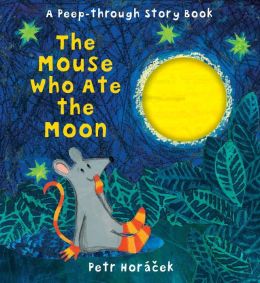
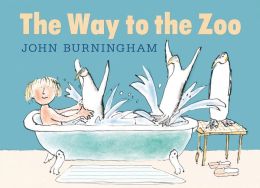

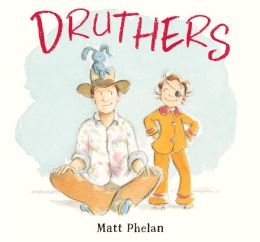
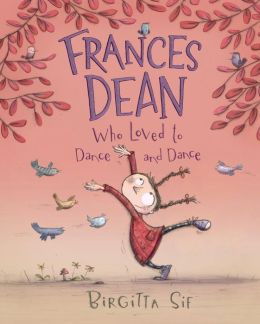

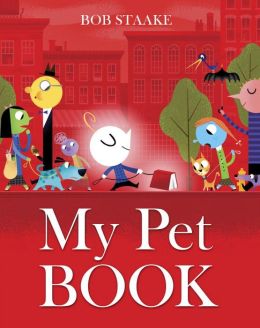
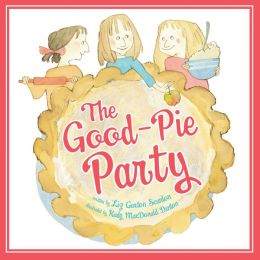

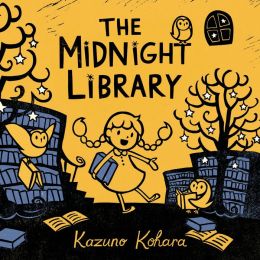
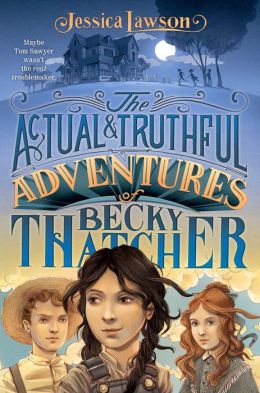









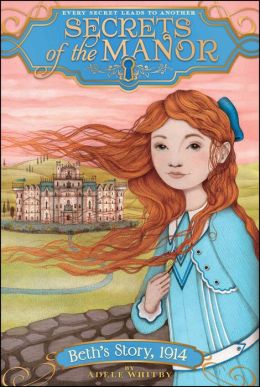








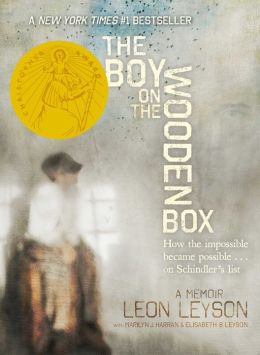





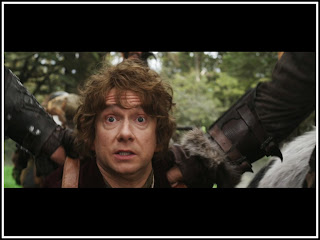


 Elizabeth Rose Staton has good news! She has been offered a contract for her first picture book! HENNY, a story about a young chick who is born just a little different from everyone else in the barn, and learns how to use her special gift to come into her own.
Elizabeth Rose Staton has good news! She has been offered a contract for her first picture book! HENNY, a story about a young chick who is born just a little different from everyone else in the barn, and learns how to use her special gift to come into her own. 

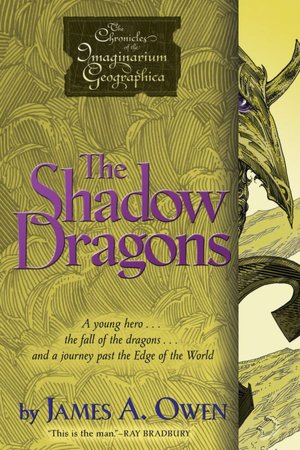
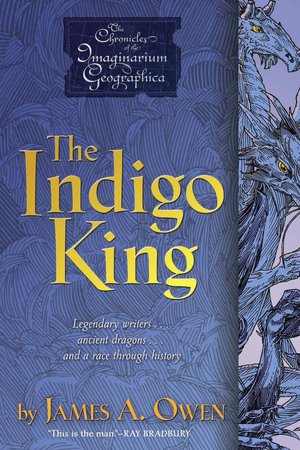
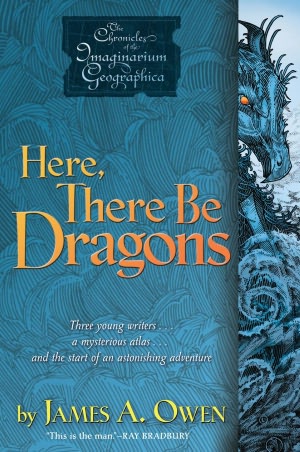



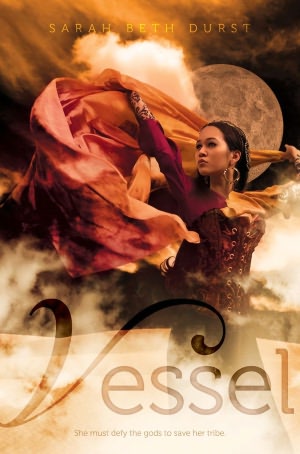






Why is Sacagewa wearing a feather in her hair? Aren’t we past stereotypical imagery yet?
Oh boy, don’t even get me started. Why are we having a resurgence of this problem? I thought we were making such good headway. On the upside, I’m sure your conversation with Marc will be fab.
I find both these recycled and new fictionalized biographies problematic–very problematic! How are we supposed to teach historical thinking with this material? Kids do not require fictionalized material to think about the past. They simply require well written nonfiction.
Note that the same feather appears in her hair, except doubled, when she’s an adult.
What time on Saturday, September 6th ?
How are these series catalogued by the Library of Congress? Are they shelved in the nonfiction section of the library? I know I’ve seen them on the nonfiction section in bookstores, but would hope libraries would be more strict (or not purchase them in the first place!).
2 p.m.
Each and every one has a Dewey Decimal Number that places it in the nonfiction section of the library. Not sure about LCC. And Worldcat will tell you which libraries have purchased them.
On the other hand, narrative nonfiction “picture book” biographies like The Boy Who Loved Math are quite amazing. Thoughts?
Absolutely it is. But there wasn’t any fictionalized dialogue in that book. All the information was well cited in the back. It was, in fact, the very antithesis of the books featured here. Proof positive that nonfiction is interesting on its own merits alone.